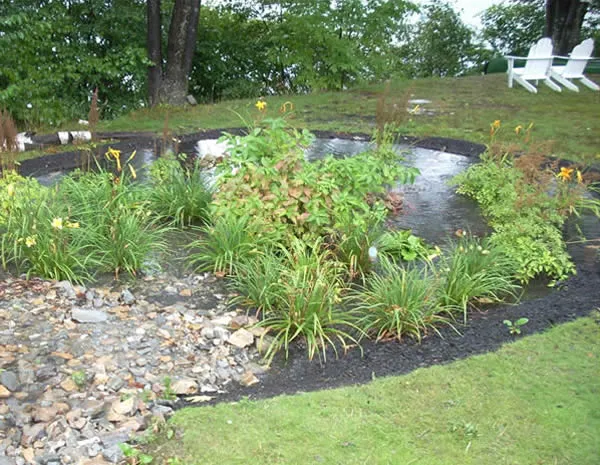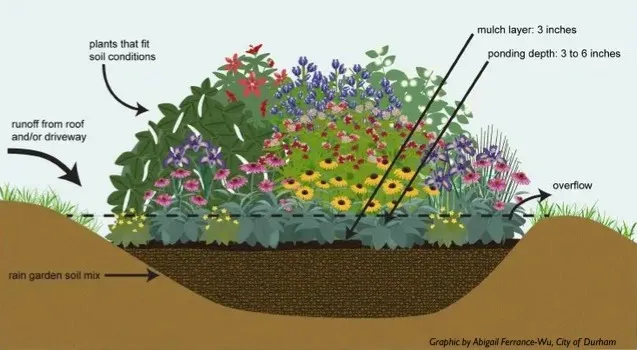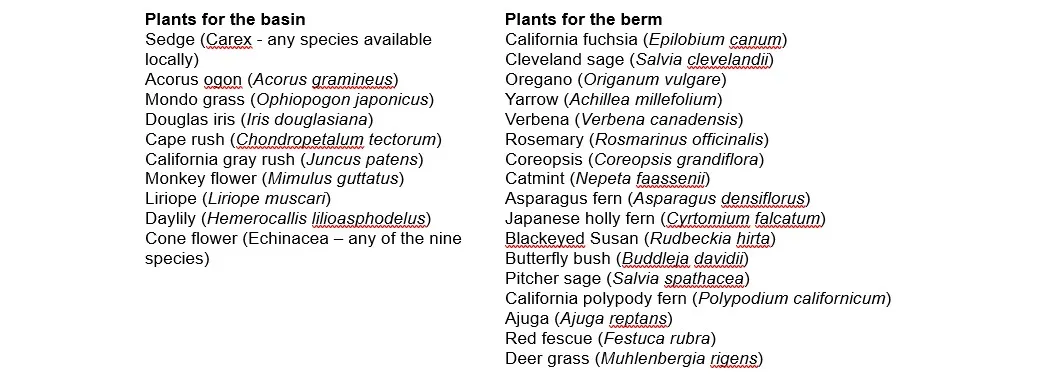
Article by Mike Kluk
Originally published in the Fall 2018 Yolo Gardener Newsletter
The recent five-year drought and the assurance we will see other drought years in the future encouraged a lot of people to install water catchment barrels. This is not a bad idea but in our Mediterranean climate, it can only go so far. For those of us who are trying to keep annual vegetables or flowers alive, the three hundred gallons or so we can store comfortably beside the house will be gone in a few weeks of hot, dry weather. And the amount that can be stored this way is tiny compared to the total that falls on the average roof and yard in the course of a winter. An addition or alternative to barrels is a rain garden. A rain garden is a depression you create, filled with plants that can tolerate periodic flooding but do not need constant watering. It will collect runoff from your yard and roof, allowing it to slowly soak into the ground. And if you have water puddling beside your foundation, you can direct that into a rain garden as well. Because rain gardens are designed to drain within forty-eight hours, they do not contribute to the local mosquito population. Rain gardens can be beautiful and practical: they reduce rainwater runoff and provide a habitat for birds and beneficial insects. Plan to invest some sweat equity into the construction, but they are easy to maintain.
A rain garden can help to extend the period when you do not need to irrigate the surrounding area. Water soaking into the adjoining soil after a spring rain can nourish neighboring plants for quite a while. It will also help to recharge the groundwater below your yard. Since about 30% of Yolo County’s water needs are met by groundwater, you can make a small contribution to the overall water health of your community.
Planning A Rain Garden
Location and size are the two main factors you will need to consider in planning your rain garden. It should be at least ten feet from your house since the soggy soil is not a good neighbor to the foundation. It also should lie several feet outside the drip line of any trees, including outside the future drip line of immature trees. Avoid areas where your garden will receive a heavy load of leaves in the fall, if possible.

The size will depend on the area you want to drain. If you can, plan your rain garden so that it will at least hold the run-off from a rainstorm that dumps an inch of rain. Calculate the area of all roof sections that will drain into the garden plus any yard area that naturally drains into the spot you have chosen. Simply calculate the cubic feet of water such an average large storm will dump into your rain garden. Then figure the area of your proposed rain garden and the proposed depth (more on that later), calculating the cubic feet of storage. Your garden is likely to have an irregular shape, so just do your best to estimate the surface area. Since a kidney shape is fairly common, I’ll give you the formula: (A + B) x length x .45 = volume where A is the width at the widest “bulge”, B the width at the smaller bulge and length is the measure of the longest axis. For all of the other odd and weird shapes you come up with, you are on your own. Most rain gardens have an area between one hundred and three hundred square feet. If you need more than 300 square feet, consider digging two basins.
You should also plan for an overflow in the event of a deluge. You can place a drain pipe just below the top edge of your basin, running it to the street or other chosen location to receive the overflow. Alternatively, you can simply leave a low spot on the edge with a corresponding ditch to carry the excess water away.
Basic Construction
Your rain garden is a depression to catch water so, unless you are lucky to have one occur naturally, you will need to dig it. A depth of eight to twelve inches is normal. You can reduce the amount of digging you need to do if you use the soil you dig out of the basin to form a berm around it. You want the bottom of your rain garden to be as level as possible. So, if you are digging on a slope you will need to dig into the hillside and build a larger berm on the downhill side.

You may need to dig deeper if you are running drain pipes off of your downspouts. You need a two percent slope running from the downspout to the garden, which is one inch in every 4.5 feet. Remember the water is not going to rise any higher than the top of the drain pipe where it enters your garden. Consider purchasing rigid three or four-inch drain pipe rather than the flexible variety. It is a little more expensive but much easier to lay on the proper slope and is not susceptible to being pierced by a spading fork or shovel down the road. If you don’t want to use piping, you can dig a “swale” from the water source to your rain garden. This is a shallow ditch dug on contour, so it has little or no slope. Water will flow into it, some will sink into the soil and some will make its way to your rain garden reservoir. You can fill a swale with attractive stones or plants.
Slope the edges of your garden gradually if you can. That will make them more habitable to plants taking root in them. Do not place the garden over a septic tank or underground utility lines. Call 811 to have your utilities marked before digging if you are concerned.
Ideally, your rain garden, once filled, will drain within twenty-four to forty-eight hours. The easiest way to determine if this will happen is to dig a small hole as deep as your finished garden will need to be. Fill it with water two or three times until the soil is saturated. The next time simply wait to see how fast it drains. Many areas have very absorbent topsoils that turn to a much less permeable hard or plow pan at a foot or so of depth. I experienced this problem when I constructed a rain garden. I knew I would need to dig down at least a foot to allow for enough slope and storage. After two days, water was still sitting in the test hole. One solution to this is to dig a few deep holes in the rain garden basin that break through the clay layer. I used a power auger and dug down about four feet. At that point, the auger hit the very sandy soil. I lined the holes with weed block and filled them with drain rock. The garden now holds water long enough for it to spread into the immediately surrounding area but drains in less than twenty-four hours.
Another approach often recommended is to dig a basin twenty-four to thirty-six inches deep. Remove the soil and fill the basin to the finished depth with a mixture of fifty percent sand, twenty-five percent soil and twenty-five percent compost. This is more work but results in a basin that is fertile for your plants and will hold a tremendous amount of water. But if you have a heavy clay layer below, standing water may still remain for an extended period of time after an especially heavy rain.
Rain garden basins are typically finished off in one of two ways. One is to plant the basin bottom and sides with plants adapted to the conditions they will face. The other is to adopt a dry stream bed look, filling the basin with a layer of stone and spotting plants in it to add interest.
Rain Garden Plants
Every rain garden contains two primary zones. The basin and edges within the flood zone and the top of the berm. Plants you put in the former must be adapted to periodic flooding but should also be able to survive with limited or no additional water in the summer. Avoid bog or water-loving plants unless you want to water constantly during the summer. Plants for the berm can include most plants adapted to your area and growing conditions except those that cannot stand any additional water infiltrating at the root level. Flannel bush (genus Fremontodendron with at least three species) and ceanothus or wild lilac (genus Ceanothus with fifty species) are examples of plants to avoid. The following is a list of a few plants that should do well in each of the zones. There are hundreds more. Be sure to consider sun/shade and irrigation requirements before making a final selection.

A rain garden can add interest and beauty to your landscaping and conserve water. If you construct one, it is likely you will be outside with an umbrella watching it fill during the first rain.
References:

